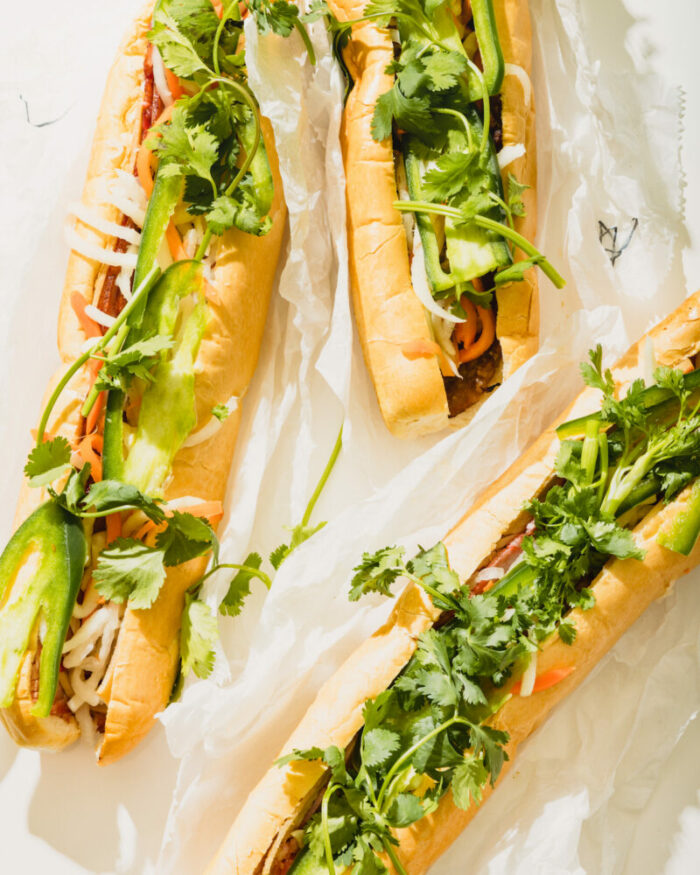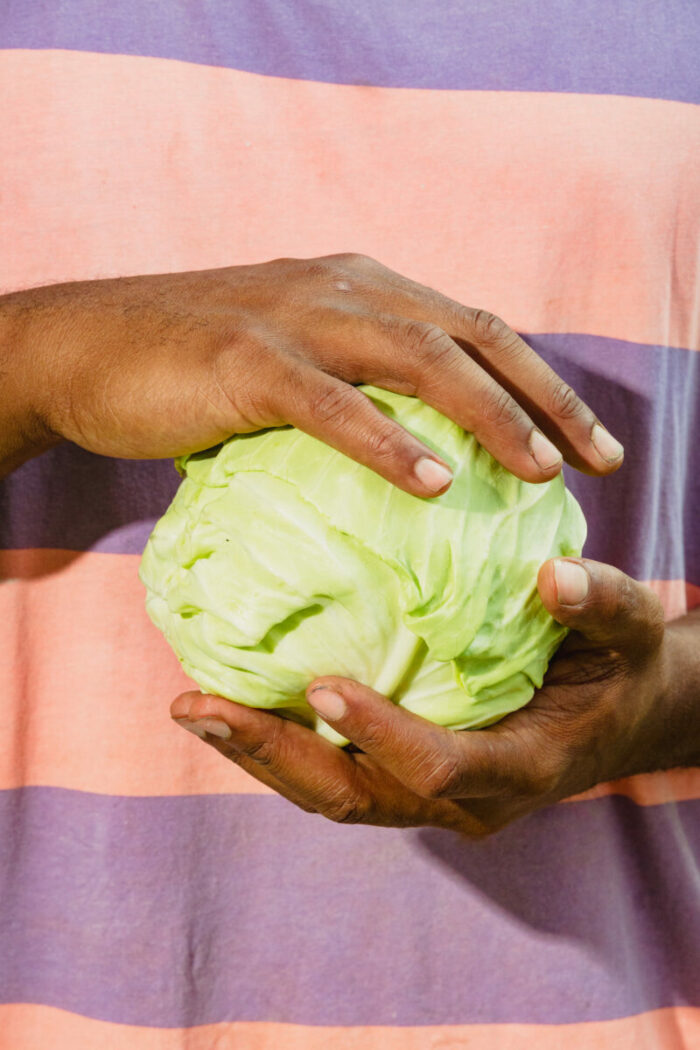"People are hungry for a different life." —Vera Fabian
In January of 2019, I began a “listening tour” across North Carolina as editor of Edible North Carolina, work that started in my food studies teaching at the University of North Carolina at Chapel Hill. The vision for this book was to create a portrait of North Carolina’s vibrant contemporary food landscape. I chose twenty leading journalists, chefs, entrepreneurs, scholars, activists, and food-focused specialists to help capture a complex world at this important moment. Chef, entrepreneur, and writer Vivian Howard opens the book with a reflection on her first iconic tastes of the state, and also witnessing its evolving food cultures. The following excerpt is from the introduction, a brief exploration of the state’s foundational food, farming, and fishing heritage.
North Carolina has been transformed by the labor, vision, and creativity of a new generation of immigrants, and nowhere is this more visible than in the state’s contemporary food economy. Asian, Latinx, and immigrants from India and South Asia increasingly came to North Carolina following the 1965 passage of legislation that altered immigration quotas in America. The 2020 U.S. census reveals marked growth in these communities, particularly in North Carolina’s urban areas. We see and taste their influence in every part of the state’s local food systems, from growing and harvesting food in the large industrial farms of eastern North Carolina and apple orchards in the mountains, to the line cooks, restaurateurs, and chefs in the region’s best restaurants, to immigrant-owned food markets in virtually every town across the state. Just outside of Chapel Hill, refugee farmers, originally from Burma, grow and market Southeast Asian vegetables on an eight-acre educational farm called Transplanting Traditions Community Farm. Executive Director Kelly Owensby says, “Despite the distances traveled and the cultures traversed, our farmers have rebuilt their farm businesses as well as their lives here in North Carolina.”1 East of Asheville, at Lee’s One Fortune Farm, Tou and Chue Lee—Hmong farmers who immigrated from Laos—grow several varieties of heirloom rice and Southeast Asian vegetables and fruits that they sell at area farmers’ markets.2 In Raleigh, members of Highland United Methodist Church established a Community Victory Garden on the church property in 2010 after realizing there was a greater use for their land than expanding the parking lot. Church members created a vibrant and extensive food resource enjoyed by new immigrants, volunteers, and people in need in the community. It has become a model for community gardens with its emphasis on health, social justice, and creating a place of refuge for all.
Second- and third-generation immigrant North Carolinians are now food entrepreneurs, journalists, policy makers, scholars, and strong stakeholders in their communities. They are consumers and investors. Even before the coronavirus pandemic upended the state’s food economy—affecting the lives of meat and poultry processing plant workers and forcing chefs to shutter restaurants—immigrant North Carolinians struggled for economic equity, access, and opportunity. Progressive activist and chef Vimala Rajendran found fruits and vegetables not unlike those of her native Mumbai in the peanuts, sweet potatoes, okra, eggplant, tomatoes, and cauliflower of the Piedmont. “Coming to Carrboro,” says Rajendran, “it just felt more like home.”3 Rajendran’s ardent stance that food is an essential human right lies at the core of her Chapel Hill restaurant, where all are served regardless of their ability to pay.
Carrboro and Chapel Hill mirror the polarization of America’s food economy: the big ag supply chain that controls most food bought by institutional purchasers such as corporate grocery chains, discount warehouses, hospitals, governments, universities, and schools and the curated food relationship among small farmers, food entrepreneurs, and well-to-do white consumers in high-end markets. Chef Andrea Reusing in Chapel Hill points to fault lines in these food systems: “The components of this inequality—racism, lack of access to capital, exploitation, land loss, nutritional and health disparities in communities of color—are tightly connected. Our nearly twenty-year obsession with food and chefs has neither expanded access to high-quality food nor improved nutrition in low-resource neighborhoods.”4 Food insecurity is growing in suburban Durham, Charlotte, and Raleigh. Yet, during these same twenty years, a corps of North Carolina food activists—farmers, extension agents, restaurateurs, chefs, scholars, public health experts, fisheries professionals, food bank managers, food hub coordinators, food aggregators, and food council leaders—have built a strong local food network. Alex Hitt observes how the customer base of local farmers’ markets is shifting, too: “In Carrboro, it flipped from fifty and older to fifty and younger. It’s families with kids now, and it happened over the last ten years.”5

Although the next generation of North Carolina’s food leaders face significant challenges from skyrocketing land prices to climate change, they are ably taking the reins of North Carolina’s food movement. In 2018 Moses Ochola, Crystal Taylor, and Ja’Nell Henry organized the Black Farmers’ Market, which alternates bimonthly between Durham and Raleigh. The market promotes Black farmers and Black-owned food businesses and also fosters a welcoming space for the Black community with projects like Tall Grass Food Box, a Durham-based CSA sourced from Black farmers in the Piedmont. Gabrielle E. W. Carter, Derrick Beasley, and Gerald Harris created the twice-monthly subscription box that brings seasonal vegetables, fruits, and eggs direct to members’ homes. In Northampton County, Julius Tillery is the fifth generation in his family to grow cotton, as well as soybeans, timber, and fresh produce, on their land in northeastern North Carolina. A UNC–Chapel Hill economics alumnus, Tillery founded Black Cotton, which markets and sells his cotton direct to consumers as home goods and clothing. Tillery describes Black families who remain “land rich and cash poor.”6 He focuses on reinvigorating Black health through access to locally grown seasonal produce at the Garysburg Town Center Farmers’ Market and helps Black farmers better monetize their farm resources.
In 2016 Kamal Bell, a farmer, former middle-school teacher, and doctoral student in agricultural and extension education at NC State University, founded Sankofa Farms near Efland in Orange County. Sankofa addresses food insecurity and racial inequity through sustainably farmed greens, beehives, and an agricultural academy for Black youth that reaffirms the cultural history of Black southerners tied to the land and the empowerment that lies in that connection. Bell is featured in Natalie Baszile’s anthology We Are Each Other’s Harvest (Amistad, 2021), a powerful celebration of Black farmers and Black-owned land across the country. “They call themselves ‘the returning generation,’” writes Baszile, “and they are fierce and unapologetic in their quest to reclaim their legacy.”7 In Pinetops, North Carolina, at Golden Organic Farm, Kendrick Ransome farms land purchased by his great- grandfather more than a hundred years ago to raise hogs and grow vegetables. Today Ransome, in his late twenties, has a CSA and provides fresh fruits and vegetables to both the local hospital and programs for children, and he plans to develop his farm as a training ground for young Black farmers. Ransome honors the farming knowledge of his ancestors while creatively shaping a new, antiracist narrative for modern Black farmers that generates both health and wealth. His location in Edgecombe County is significant due to the region’s historic presence of independent Black farmers and communities like Princeville, estabished by freed Blacks as “Freedom Hill” in 1885. In 2018, the Cooperative Extension program at NC A&T recognized Duplin County farmer Ronald Simmons as North Carolina’s small farmer of the year for his work in pasture-raised pork at Master Blend Family Farms near Kenansville. The family also operates a general store at the farm where they sell pork and other locally grown products.

A 2020 ASAP survey revealed that of their member farmers in western North Carolina, 46 percent were women and 29 percent were new farmers who have farmed for ten years or less.8 Yesod Farm + Kitchen, twenty-five miles outside Asheville, was cofounded by SJ Seldin with executive director Shani Mink of the Jewish Farmer Network, a national organization based in western North Carolina that provides retreat space and experiential education at the intersection of Judaism and farming. Focused on regenerative agriculture, they steward sixteen acres of land whose deep history lies in the Catawba and Cherokee people who once lived here.
Dallas Robinson moved back home to farm family-owned land in Whitakers, North Carolina, in 2019. She named it the Harriet Tubman Freedom Farm. After studying the destructive history of America’s globalized food system at Vassar College and apprenticing in a farm immersion program at Soul Fire Farm in New York State, Robinson turned to sustainable small-scale farming as a response to racial trauma and disparity. She grows vegetables for a CSA and sells sorghum to local breweries and plans to transition to a cooperative-run farm. Black liberation and Indigenous sovereignty are at the heart of her work. In Wake County at Oliver’s AgroForest, Olivia Watkins grows organic shiitake mushrooms on land that her ancestors purchased and farmed in the 1890s. She plans to raise bees and grow produce and flowers. A Barnard College alumna with an MBA from NC State University, Watkins is the fifth generation of her North Carolina family to steward this land. Her focus lies in food sovereignty, community, and forest conservation. Watkins is cofounder and president of the Black Farmer Fund.
Vera Fabian and Gordon Jenkins started to grow organic vegetables intensively on their small Piedmont farm, Ten Mothers Farm, in 2015 with hoop houses, no tilling, and no tractor. Gordon grew up on the West Coast, and Vera is a native North Carolinian. They trained with some of the country’s best farmers and leaders of the local food movement, including restaurateur and chef-activist Alice Waters of Chez Panisse in Berkeley, California, small-scale, sustainable farmers Elliot Coleman and Barbara Damrosch in Harborside, Maine, and two of the founding farmers of the Carrboro Farmers’ Market, Ken Dawson and Libby Outlaw in Cedar Grove, North Carolina. “In the young farm scene these days, there are more and more of us,” says Fabian, who is in her early thirties. “Our customers are part of the local food movement; they’re choosing to be part of our farm. They might do it because of health or because they know that the vegetables taste better, but there’s something bigger than just us that they want to be part of. People are hungry for a different life.”9
From Edible North Carolina: A Journey Across a State of Flavor. Copyright © 2022 by Marcie Cohen Ferris. Used by permission of the University of North Carolina Press. www.uncpress.org
Marcie Cohen Ferris is an author, educator, and scholar whose work focuses on the American South through its foodways, the southern Jewish experience, and material culture. She is an emeritus professor in the Department of American Studies at the University of North Carolina at Chapel Hill and an editor for Southern Cultures, a quarterly journal of the history and cultures of the U.S. South. Ferris is the author of Matzoh Ball Gumbo: Culinary Tales of the Jewish South (UNC Press, 2005) and The Edible South: The Power of Food an the Making of an American Region (UNC Press, 2014).
Marcie Cohen Ferris, Editor; K.C. Hysmith, Associate Editor; Photography by Baxter Miller; Ryan Stancil, Creative Producer for Photography; Foreword by Vivian Howard. Contributors include Shorlette Ammons, Karen Amspacher, Victoria Bouloubasis, Katy Clune, Gabe Cummings, Marcie Cohen Ferris, Sandra Gutierrez, Tom Hanchett, Michelle King, Cheetie Kumar, Courtney Lewis, Malinda Maynor Lowery, Ronni Lundy, Keia Mastrianni, April McGreger, Ricky Moore, Carla Norwood, Kathleen Purvis, Andrea Reusing, Bill Smith, Maia Surdam, and Andrea Weigl.
Header image: Eggs, Hickory Nut Gap Farm, Fairview, North Carolina; Carolina Ground flour, Asheville, North Carolina; Spanish mackerel and pompano, Ocracoke Seafood Company, Ocracoke, North Carolina; Ruby Streaks Mustard, grown by Jamie Swofford; Sam Suchoff holding a long-aged country ham, Chapel Hill, North Carolina.NOTES
- Kelly Owensby, email to Marcie Cohen Ferris, December 10, 2020.
- Adam Rosen, “Rice in Appalachia? Meet the Farmers Growing Traditional Laotian Foods in North Carolina’s Hills,” 100 Days in Appalachia, November 23, 2020, www.100daysinappalachia.com/2020/11/rice-in-appalachia -meet-the-farmers-growing-traditional-laotian-foods-in-north-carolinas-hills/.
- Vimala Rajendran, interview by Marcie Cohen Ferris, April 29, 2019.
- Andrea Reusing, “Farm-to-Table May Feel Virtuous, But It’s Food Labor That’s Ripe for Change,” The Salt, NPR, July 30, 2017, www.npr.org/sections /thesalt/2017/07/30/539112692/a-chefs-plea.
- Alex and Betsy Hitt, interview by Marcie Cohen Ferris, January 30, 2019.
- Julius Tillery, interview by Marcie Cohen Ferris, June 3, 2019.
- Natalie Baszile, We Are Each Other’s Harvest: Celebrating African American Farmers, Land, and Legacy (New York: Amistad, 2021), 3.
- Appalachian GrownTM 2019 Producer Survey Report (Asheville, N.C.: Local Food Research Center, ASAP, June 2020), https://asapconnections.org/report/2019-appalachian-grown-producer-survey-report/.
- Vera Fabian, interview by Marcie Cohen Ferris, April 17, 2019.


